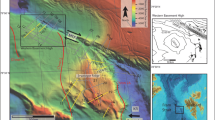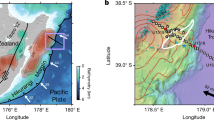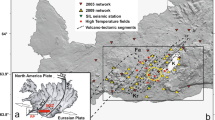Abstract
Newly forming subduction zones on Earth can provide insights into the evolution of major fault zone geometries from shallow levels to deep in the lithosphere and into the role of fluids in element transport and in promoting rock failure by several modes1,2. The transpressional subduction regime of New Zealand, which is advancing laterally to the southwest below the Marlborough strike–slip fault system of the northern South Island3,4, is an ideal setting in which to investigate these processes. Here we acquired a dense, high-quality transect of magnetotelluric soundings across the system, yielding an electrical resistivity cross-section to depths beyond 100 km. Our data imply three distinct processes connecting fluid generation along the upper mantle plate interface to rock deformation in the crust as the subduction zone develops. Massive fluid release just inland of the trench induces fault-fracture meshes through the crust above that undoubtedly weaken it as regional shear initiates. Narrow strike–slip faults in the shallow brittle regime of interior Marlborough diffuse in width upon entering the deeper ductile domain aided by fluids and do not project as narrow deformation zones. Deep subduction-generated fluids rise from 100 km or more and invade upper crustal seismogenic zones that have exhibited historic great earthquakes on high-angle thrusts that are poorly oriented for failure under dry conditions. The fluid-deformation connections described in our work emphasize the need to include metamorphic and fluid transport processes in geodynamic models.
This is a preview of subscription content, access via your institution
Access options
Subscribe to this journal
Receive 51 print issues and online access
$199.00 per year
only $3.90 per issue
Buy this article
- Purchase on Springer Link
- Instant access to full article PDF
Prices may be subject to local taxes which are calculated during checkout



Similar content being viewed by others
References
Stern, R. J. Subduction initiation: spontaneous and induced. Earth Planet. Sci. Lett. 226, 275–292 (2004)
Schellart, W. P., Freeman, J., Stegman, D. R., Moresi, L. & May, D. Evolution and diversity of subduction zones controlled by slab width. Nature 446, 308–311 (2007)
Walcott, R. I. Models of oblique compression: Late Cenozoic tectonics of the South Island of New Zealand. Rev. Geophys. 36, 1–26 (1998)
Furlong, K. P. in Exhumation Associated with Continental Strike-Slip Fault Systems (eds Till, A. B., Roeske, S. M., Sample, J. C. & Foster, D. A.) Geol. Soc. Am. Spec. Pap. 434 1–14 (GSA, 2008)
Wesnousky, S. G. Seismicity as a function of cumulative geologic offset: some observations from southern California. Bull. Seismol. Soc. Am. 80, 1374–1381 (1990)
Davey, F. J. et al. in A Continental Boundary: Tectonics at South Island, New Zealand (eds Okaya, D., Stern, T. & Davey, F.) Geophys. Monogr. 175 47–73 (American Geophysical Union, 2007)
Becken, M. et al. A deep crustal fluid channel into the San Andreas Fault system near Parkfield, California. Geophys. J. Int. 173, 718–732 (2008)
Mortimer, N. New Zealand’s geological foundations. Gondwana Res. 7, 261–272 (2004)
Jongens, R. Structure of the Buller and Takaka terrane rocks adjacent to the Anatoki fault, northwest Nelson, New Zealand. NZ J. Geol. Geophys. 49, 443–461 (2006)
Ghisetti, F. C. & Sibson, R. H. Accommodation of compressional inversion in north-western South Island (New Zealand): old faults versus new? J. Struct. Geol. 28, 1994–2010 (2007)
Heise, W. et al. Melt distribution beneath a young continental rift: the Taupo Volcanic Zone, New Zealand. Geophys. Res. Lett. 34 L14313 10.1029/2007GL029629 (2007)
Jones, A. G. Imaging the continental upper mantle using electromagnetic methods. Lithos 48, 57–80 (1999)
Peacock, S. M. in Inside the Subduction Factory (ed. Eiler, J.) Am. Geophys. Monogr. 138 7–22 (American Geophysical Union, 2003)
Reyners, M., Eberhart-Phillips, D. & Stuart, G. The role of fluids in lower-crustal earthquakes near continental rifts. Nature 446, 1075–1079 (2007)
Ogawa, Y. & Honkura, Y. Mid-crustal electrical conductors and their correlations to seismicity and deformation at Itoigawa-Shizuoka tectonic line, central Japan. Earth Planets Space 56, 1285–1292 (2004)
Eberhart-Phillips, D., Chadwick, M. & Bannister, S. Three-dimensional attenuation structure of central and southern South Island, New Zealand, from local earthquakes. J. Geophys. Res. 113 B05308 10.1029/2007JB005359 (2008)
Eberhart-Phillips, D. & Henderson, M. C. Including anisotropy in 3-D velocity inversion and application to Marlborough, New Zealand. Geophys. J. Int. 156, 237–254 (2004)
Cox, S. F. Coupling between deformation, fluid pressures, and fluid flow in ore-producing hydrothermal systems at depth in the crust. Soc. Econ. Geol. 100th Anniv. Vol., 39–75 (2005)
Bourne, S. J., England, P. C. & Parson, B. The motion of crustal blocks driven by flow in the lower lithosphere and implications for slip rates of continental strike-slip faults. Nature 391, 655–659 (1997)
Wilson, C. K., Jones, C. H., Molnar, P., Sheehan, A. F. & Boyd, O. S. Distributed deformation in the lower crust and upper mantle beneath a continental strike-slip fault zone: Marlborough fault system, South Island, New Zealand. Geology 32, 837–840 (2004)
Nicol, A. & Van Dissen, R. Up-dip partitioning of displacement components on the oblique-slip Clarence fault, New Zealand. J. Struct. Geol. 24, 1521–1535 (2002)
Mason, D. P. M., Little, T. A. & Van Dissen, R. J. Rates of active faulting during late Quaternary fluvial terrace formation at Saxton River, Awatere fault, New Zealand. Geol. Soc. Am. Bull. 118, 1431–1466 (2006)
Cox, S. F. in Fractures, Fluid Flow and Mineralization (ed. McCaffrey, K. J. W., Lonergan, L. & Wilkinson, J. J.) Geol. Soc. Lond. Spec. Pub. 155 123–140 (GSL, 1999)
Sibson, R. H. in Deformation of the Continental Crust: the Legacy of Mike Coward Geol. Soc. Lond. Spec. Publ. 272 519–532 (GSL, 2007)
Wannamaker, P. E. et al. Fluid generation and pathways beneath an active compressional orogen, the New Zealand Southern Alps, inferred from magnetotelluric data. J. Geophys. Res. 107 10.1029/2001JB000186 (2002)
Patro, P. K. & Egbert, G. D. Regional conductivity structure of Cascadia: preliminary results from 3D inversion of USArray transportable array magnetotelluric data. Geophys. Res. Lett. 35 10.1029/2008GL035326 (2008)
Brasse, H. & Eydam, D. Electrical conductivity beneath the Bolivian orocline and its relation to subduction processes at the South American continental margin. J. Geophys. Res. 113 10.1029/2007JB005142 (2008)
Jiracek, G. R., Gonzalez, V. M., Caldwell, T. G., Wannamaker, P. E. & Kilb, D. in A Continental Boundary: Tectonics at South Island, New Zealand (eds Okaya, D., Stern, T. & Davey, F.) Geophys. Monogr. Ser. 175 75–94 (Am. Geophys. Union, 2007)
Upton, P. & Koons, P. O. in A Continental Boundary: Tectonics at South Island, New Zealand (eds Okaya, D., Stern, T. & Davey, F.) Geophys. Monogr. Ser. 175 253–270 (Am. Geophys. Union, 2007)
Beavan, J., Ellis, S. & Wallace, L. in A Continental Boundary: Tectonics at South Island, New Zealand (eds Okaya, D., Stern, T. & Davey, F.) Geophys. Monogr. Ser. 175 75–94 (Am. Geophys. Union, 2007)
Vozoff, K. in Electromagnetic Methods in Applied Geophysics (ed. Nabighian, M. N.)2B 641–711 (Soc. Explor. Geophys., 1991)
Booker, J. R., Favetto, A. & Pomposiello, M. C. Low electrical resistivity associated with plunging of the Nazca flat slab beneath Argentina. Nature 429, 399–404 (2004)
Petiau, G. & Dupis, A. Noise, temperature coefficient, and long time stability of electrodes for telluric observations. Geophys. Prospect. 28, 792–804 (1980)
Wannamaker, P. E. et al. Magnetotelluric surveying and monitoring at the Coso geothermal area, California, in support of the Enhanced Geothermal Systems concept: survey parameters and initial results. Proc. Workshop Geothermal Reservoir Engr. SGP-TR-175 1–8 (Stanford University, 2004)
Jones, A. G., Chave, A. D., Egbert, G., Auld, D. & Bahr, K. A comparison of techniques for magnetotelluric response function estimation. J. Geophys. Res. 94, 14201–14213 (1989)
Caldwell, T. G., Bibby, H. M. & Brown, C. The magnetotelluric phase tensor. Geophys. J. Int. 158, 457–469 (2004)
Wannamaker, P. E. in Three-Dimensional Electromagnetics (ed Oristaglio, M. & Spies, B.) Geophys. Devel. Ser. 7 349–374 (Soc. Explor. Geophys., 1999)
Wannamaker, P. E. et al. Lithospheric dismemberment and magmatic processes of the Great Basin-Colorado Plateau transition, Utah, implied from magnetotellurics. Geochem. Geophys. Geosyst. 9 Q05019 10.1029/2007GC001886 (2008)
Acknowledgements
This research was supported by the Geophysics program of the US National Science Foundation (grant EAR0440050), and the Plate Boundary program of the New Zealand Foundation for Research, Science and Technology. W. Hales of Alpine Springs Helicopters provided an airborne transport service to remote locations of the Marlborough and Westland regions. We thank B. Freer, C. Davis and P. Thorton of the New Zealand Department of Conservation, and numerous private landholders, for permission to access site locations. Additional field assistance was given by students M. Burgess and P. Winther. Many discussions were held with D. Eberhart-Phillips, R. Sibson and P. Upton. Illustrations were finalized by D. Jensen.
Author Contributions P.E.W., T.G.C. and G.R.J. designed the experiment. The home institutions of T.G.C. and Y.O. supplied the instrumentation. T.G.C. and G.J.H. reduced the observed time series. V.M. derived the induction vectors. All authors were essential to the success of the field campaign and contributed to the interpretation and the manuscript.
Author information
Authors and Affiliations
Corresponding author
Supplementary information
Supplementary Information
This file contains a Supplementary Discussion, Supplementary Data, Supplementary References and Supplementary Figures 1-13 with Legends. (PDF 1294 kb)
Rights and permissions
About this article
Cite this article
Wannamaker, P., Caldwell, T., Jiracek, G. et al. Fluid and deformation regime of an advancing subduction system at Marlborough, New Zealand. Nature 460, 733–736 (2009). https://doi.org/10.1038/nature08204
Received:
Accepted:
Issue Date:
DOI: https://doi.org/10.1038/nature08204
This article is cited by
-
Magnetotelluric Power Line Noise Removal Using Temporally Varying Sinusoidal Subtraction of the Grid Utility Frequency
Pure and Applied Geophysics (2023)
-
Fluids and physicochemical properties and processes in the Earth
Progress in Earth and Planetary Science (2022)
-
Trans-crustal structural control of CO2-rich extensional magmatic systems revealed at Mount Erebus Antarctica
Nature Communications (2022)
-
Slab-derived fluid storage in the crust elucidated by earthquake swarm
Communications Earth & Environment (2022)
-
Magnetotelluric resistivity imaging of the Baribis fault zone’s Majalengka segment in West Java, Indonesia
Acta Geodaetica et Geophysica (2022)
Comments
By submitting a comment you agree to abide by our Terms and Community Guidelines. If you find something abusive or that does not comply with our terms or guidelines please flag it as inappropriate.



